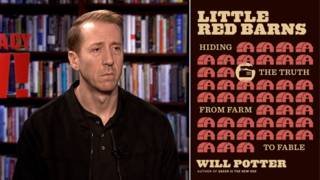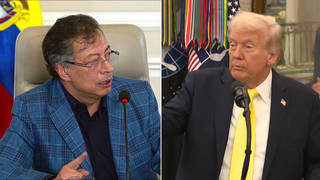
Topics
Guests
- Dave Philippsinvestigative reporter. His latest piece for ProPublica is titled “All the Missing Horses: What Happened to the Wild Horses Tom Davis Bought From the Gov’t?” He is also the author of Lethal Warriors: When the New Band of Brothers Came Home. In 2009, he wrote the award-winning two-part series “Casualties of War” for the Colorado Springs Gazette. He’s now working on a new book, Misfits: Wild Horses in the 21st Century.
In a new investigation, ProPublica reporter Dave Philipps tracks what happens to many of the wild horses rounded up in the western United States by the Bureau of Land Management. A little-known livestock hauler named Tom Davis is buying almost all of the horses the bureau removes from the wild, in a program meant to maintain a sustainable balance among the herds. Like all buyers in the program, Davis signs a contract promising the animals will not be slaughtered and insists he finds them good homes. But Davis is a longtime advocate of horse slaughter, and he refuses to disclose where the horses end up. Animal welfare advocates fear the horses he buys are being sent to the killing floor. [includes rush transcript]
Transcript
AMY GOODMAN: As we continue the western leg of our 100-city Silenced Majority tour, we turn now to a new investigation that tracks what happens to many of the wild horses rounded up in this region by the Bureau of Land Management. Dave Philipps reports for the investigative news outlet ProPublica that a little-known livestock hauler is buying almost all the horses the bureau removes from the wild, in a program meant to maintain a sustainable balance among the herds. Like all buyers in the program, Tom Davis signs a contract promising the animals will not be slaughtered and insists he finds them good homes. But Davis is a longtime advocate of horse slaughter, and he refuses to disclose where the horses end up. Animal welfare advocates fear the horses he buys are being sent to the killing floor.
For more, we turn now to my interview with Dave Philipps. I spoke with him last Friday in Colorado Springs, and I began by asking him what happened to these wild horses.
DAVID PHILIPPS: Before I tell you that, let’s just take a second to appreciate the fact that there are wild horses out there right now, thousands of wild horses in the West that are still this part of the old Wild West that never got tamed. These are horses that are protected by the government, much like an endangered species.
Now, what happened to them? Well, the government has taken some of them off the land, and it tries to sell them. It says repeatedly, emphatically, that it is so careful of who it sells them to, that none—it knows for a fact that none are ever slaughtered or even sold to people who might resell them to slaughter. What we found in our investigation, in fact, is that they never check up on any of these claims, and they are selling one man in Colorado, this guy Tom Davis—they’ve sold him 1,700 horses over the past three years.
AMY GOODMAN: Who has sold them?
DAVID PHILIPPS: The Bureau of Land Management, which is part of the Interior Department. Essentially, the federal government has sold these horses that it takes off of the range to this one buyer. Where they go, the government doesn’t know, and Tom Davis is not telling. But evidence suggests that he is sending them to Mexico to slaughter.
AMY GOODMAN: Sending the horses how to Mexico?
DAVID PHILIPPS: Well, that’s a tricky question to answer. He sends them down to Texas, which is a very good place to sell horses without leaving a paper trail. Perhaps then somebody else exports them. We were unable to get export documents from the USDA; they wouldn’t share them with us. And within Mexico is this big industry, run mostly by European companies, that takes American horses, butchers them and then ships them over to Europe to be sold as steaks.
AMY GOODMAN: Wild horse meat?
DAVID PHILIPPS: Overwhelmingly, this industry is domestic horses, old, unused horses that no one wants and sells into slaughter. But what we found is that there are horses that—wild horses that are illegally slipping into this system, people that are selling them in, and the government’s policing practices are so inadequate that not only do they never catch these guys, but they don’t even say it’s a problem.
AMY GOODMAN: Is horse—where is horse meat a delicacy?
DAVID PHILIPPS: You would be surprised. You can go to Japan and have horse sushi. But—
AMY GOODMAN: Horse sushi?
DAVID PHILIPPS: Absolutely. And, in fact, we—the horses are also turned into other products. They’re turned into hair weaves. They’re turned into mattress pads. But generally speaking, northern Europe, Belgium, France, is where the market for this meat is.
AMY GOODMAN: Who tipped you off to this story, Dave Philipps?
DAVID PHILIPPS: I was in the middle of the desert in Nevada, and a very smart wild horse advocate named Laura Leigh said to me, “You know, you should look at the horse sale program and see if anything’s slipping out of there, because they won’t tell us. We’ve asked about this. We’ve asked the Bureau of Land Management, and they won’t give us a straight answer.”
And so we started digging up documents using the Freedom of Information Act. And what it showed was so stark immediately. Most of the people who buy horses from the government are buying one or two. They’re adopted horses that they are going to use as companion animals. This guy was buying literally truckloads at a time, sometimes—
AMY GOODMAN: Tom Davis.
DAVID PHILIPPS: Yeah, Tom Davis. Sometimes up to 240 horses at one purchase. And he accounted for 70 percent of their entire sale program.
AMY GOODMAN: How much is he purchasing them for?
DAVID PHILIPPS: They only cost him $10. Now—
AMY GOODMAN: A horse, a live horse, costs $10. How much does a horse weigh?
DAVID PHILIPPS: These horse might be anywhere between 700 and 1,400 pounds. What’s interesting is the government spends thousands of dollars to gather these horses up, and then they ship them to Tom Davis for free. Oftentimes that trucking bill is $5,000.
AMY GOODMAN: Where is his farm?
DAVID PHILIPPS: This is where it gets really interesting. He lives down in a very rural and beautiful place in Colorado called the San Luis Valley. He is literally just down the road from the farm of Ken Salazar, who’s the secretary of the interior, and has a long business relationship with him.
AMY GOODMAN: What do you mean, “a long business relationship”?
DAVID PHILIPPS: He has often hauled cattle for Salazar, who is a rancher. They know each other. They’ve known each other for decades.
AMY GOODMAN: Does Ken Salazar know about this? Did you attempt to interview the secretary of the interior?
DAVID PHILIPPS: I attempted multiple times—multiple, multiple times—and never got a word out of him. However, I do know that Tom Davis, the buyer, wanted to start his own horse slaughter plant there right next to his ranch and tried to enlist the help of Ken Salazar’s brother, who is our state Department of Agriculture chief, to try and help him get it started.
AMY GOODMAN: Former congressman.
DAVID PHILIPPS: Absolutely. Now, John Salazar refused, saying it was—you know, it was a too politically hot topic, but wished him luck, according to Davis.
AMY GOODMAN: So, $5,000, the U.S. government spends, taxpayer dollars—
DAVID PHILIPPS: That’s just for the shipping.
AMY GOODMAN: —to ship a horse to Tom Davis, who buys it for $10.
DAVID PHILIPPS: It would be a truckload of 30 horses. So he’d buy that truckload of horses for $300.
AMY GOODMAN: And they would pay $5,000 to get it to—
DAVID PHILIPPS: After probably paying—
AMY GOODMAN: —to get the horses to him.
DAVID PHILIPPS: —a thousand dollars a horse, probably also to gather it, at least. So let’s say that the government’s total expense is $35,000. He pays $300.
AMY GOODMAN: What could be the justification for this?
DAVID PHILIPPS: Well, the BLM has been taking excess horses—what it deems excess horses—off of the range for years. And it tries to adopt them out but has very few takers. And so, what it ends up doing is contracting private ranchers, mostly in Oklahoma and Kansas, to essentially put them up in a horse retirement home. This is really, really expensive. And listen to this—
AMY GOODMAN: A horse retirement home?
DAVID PHILIPPS: There are now—they’ve now removed so many horses and put them in these horse retirement homes, that there are more wild horses in the retirement homes—47,000 of them—than there are in the wild. The BLM—this is extremely expensive. And so, the BLM wants to try and get rid of these horses. It just doesn’t have a good way to do it. And so, some people suggested to me in my research, it may be that the BLM is looking the other way and letting this buyer, Tom Davis, break the law, because, in a way, he’s helping them out. He is putting relief on this overloaded system of horse storage.
AMY GOODMAN: How—who could you speak about to learn more about who Tom Davis is?
DAVID PHILIPPS: Tom Davis is, in many ways, just a rural guy, a guy who grew up around horses his whole life. He makes his living hauling cattle for people around Colorado. He is not a special guy in any sense. He lives in a very modest house down in a pretty remote and impoverished part of the state. For some reason, and a reason that honestly I can’t say, the BLM has just decided that it’s OK to sell him hundreds and hundreds of horses and never check what he’s doing with them. Now, there are people within the wild horse welfare world, people who love these horses, who have said, “If someone is buying this many horses, BLM, there’s only one thing he could be doing with them: sending them to slaughter.” And the BLM has responded, “No, no, no. We’ve checked this guy out. We have a long relationship with him, and he is above reproach.”
AMY GOODMAN: Who are the advocates for the horses?
DAVID PHILIPPS: The advocates for the horses are all sorts of people, mostly who live near these bands of horses out in remote places—Nevada, Utah, Colorado—who have become captivated by just watching these herds, seeing them roam free out there—also people in cities. And they watch the BLM very closely, or try to. They advocate for these horses to be treated better than they are. But they have had a lot of trouble trying to figure out what the sale program is doing, because the BLM has been really secretive about it. They treat it like they’re selling, you know, chemical weapons, when in fact it’s just, you know, basically livestock.
AMY GOODMAN: Dave Philipps, we’re broadcasting from Durango on Tuesday. Talk about the Western Slope of Colorado, where the wild horses roam.
DAVID PHILIPPS: Well, Colorado—western Colorado has some beautiful horse herds all up and down sort of the western border. I think there’s four recognized herds. And what’s interesting about them is, genetic tests have been done on a lot of these horses, and wild horses are a mix of anything that ever got away from anybody. You know, it could be a draft horse that pulled a wagon, it could be a cavalry horse, you name it. But these horses have a lot of old blood in them that suggests that these are still remnants that are left over from the Ute Indians, who once controlled all of Colorado, mixed with everything else, like everything in America is mixed up. But they’re still there, and really, to a large extent, they still are how they were 300 years ago.
AMY GOODMAN: You’re turning this into a book, your research.
DAVID PHILIPPS: Mm.
AMY GOODMAN: What captivated you about the wild horses and what’s happening to them?
DAVID PHILIPPS: I started with the stark, surprising figure that there are more wild horses in captivity than in the wild. There’s no other animal like that in the world. You know, here is an animal that is wild, but not wildlife, right? It’s feral. It is sort of an American symbol, and yet not a native. In a way, it’s a lot like we are, and it shares a lot of our history—you know, mixed-up immigrants out here trying to find our place within the landscape. And it has a deep history that is tied to us.
There were once maybe two million wild horses in the West, herds that went for miles and were rivaled only by the buffalo. And to a large extent, they were annihilated, like the buffalo were. They were shipped east by the trainload and turned into baseball covers. They were ground up and turned into fertilizer and chicken feed, until, by the 1970s, there was only a fraction left. And then we protected them. And since then, they’ve started to come back. There’s now 35,000 or so.
And it was an interesting issue to me, because now they have to find their place, this part of the New West in the Old West. How do we do that? How do we, as people, work together to try and find a sustainable way to make room for both us, native wildlife and this interesting part of our heritage?
AMY GOODMAN: That was reporter Dave Philipps. I spoke with him on Friday in Colorado Springs about his new investigation for ProPublica titled “All the Missing Horses: What Happened to the Wild Horses Tom Davis Bought From the Gov’t?” We’ll link to it at our website at democracynow.org. And we’re broadcasting from Durango, Colorado, today, where there are wild horses on the Western Slope.












Media Options